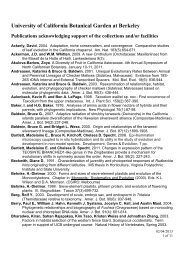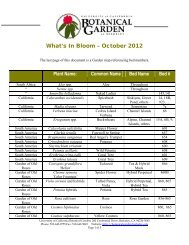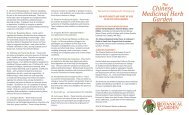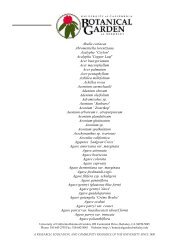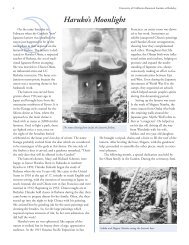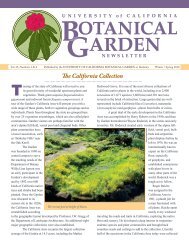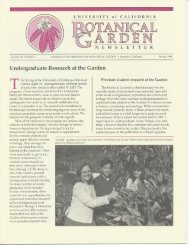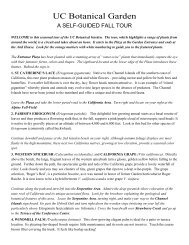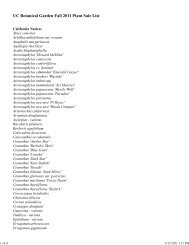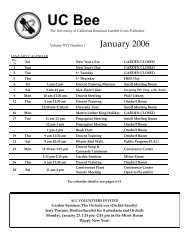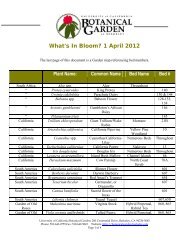Poisonous plants - The University of California Botanical Garden ...
Poisonous plants - The University of California Botanical Garden ...
Poisonous plants - The University of California Botanical Garden ...
Create successful ePaper yourself
Turn your PDF publications into a flip-book with our unique Google optimized e-Paper software.
UNIVERSITY OF CALIFORNIA BERKELEY<br />
<strong>Botanical</strong> G arden<br />
Ouarterly<br />
<strong>Botanical</strong><br />
iii l!! .3:;i1'::i!::::<br />
ii! ::: l!: iiii:it.<br />
ili;:i!;. ii::;, i!i;ri!:<br />
Ga rden<br />
Friends <strong>of</strong> the <strong>Botanical</strong> <strong>Garden</strong> vol. 1,no.4 Spfing l-e78<br />
Plant sale<br />
<strong>The</strong> 4th Annual Spring Plant Sale,<br />
sponsored by the botanical garden's docents,<br />
will be held Saturday, May 13.<br />
<strong>The</strong> sale will take place in the rim section<br />
<strong>of</strong> the UC Memorial Stadium (at the<br />
junction <strong>of</strong> Rimway Drive and Centennial<br />
Drive) from 9 a.m. to 2 p.m.<br />
Members <strong>of</strong> the Friends <strong>of</strong> the <strong>Botanical</strong><br />
<strong>Garden</strong> are also invited to a special<br />
pre-plant sale on Saturday, May 6, from<br />
I to 4 p.m. ar the <strong>Botanical</strong> <strong>Garden</strong>. If<br />
you are not yet a member <strong>of</strong> the Friends<br />
<strong>of</strong> the <strong>Botanical</strong> <strong>Garden</strong>, you will be<br />
able to join on the day <strong>of</strong> the sale. l\Vo<br />
extra will be added to the prices for this<br />
privilege <strong>of</strong> buying <strong>plants</strong> prior to the<br />
main sale.<br />
<strong>Poisonous</strong> <strong>plants</strong><br />
By Laurianne L. Hannan, Educational Coordinator<br />
An impressive selection<br />
<strong>The</strong> sale will be divided into sections<br />
to aid you in finding your special plant.<br />
Several <strong>of</strong> the larger sections include<br />
"<strong>California</strong> natives," "trees and<br />
shrubs," "cacti and succulents," and<br />
"perennials. " Interesting natives which<br />
will be available include Matillija<br />
poppy (Romneya coulteri), pitcher sage<br />
(Salaia spathacea), and yerba de selva<br />
(Whipplea modesta). In the "trees and<br />
shrubs" section, the empress tree<br />
(P aulownia glabrata), camellia (Camellia<br />
sasanqua), many conifers, numerous<br />
sages, and several barberries will be for<br />
sale. For the succulent buffs, many<br />
species and varieties <strong>of</strong> Agaae, Aloe,<br />
Crassula, Dudleya, Echeaeria, Kalanchoe,<br />
Senecio and Haworthin will be <strong>of</strong>fered. as<br />
well as numerous species <strong>of</strong> euphorbias<br />
and cacti. Also, many perennials, including<br />
Pelargonium, Erysimum, and Hel-<br />
Ieborus will be available.<br />
Other smaller sections <strong>of</strong> <strong>plants</strong> include<br />
"herbs," "orchids," "fuchsias,"<br />
"ferns," "rhododendrons," "rock garden<br />
<strong>plants</strong>," "fruits and vegetables,"<br />
and "vines." Prices will be reasonable<br />
and the selection impressive. Make a<br />
note to attend this event.<br />
<strong>The</strong> evolving plant sale<br />
<strong>The</strong> plant sale had its beginning in<br />
1974 when a group <strong>of</strong> the garden's docents,<br />
led by Mrs. Jeanne Vogt, decided<br />
that a small plant sale might be a way <strong>of</strong><br />
bringing funds into the garden as well<br />
continued on Page 2<br />
<strong>The</strong> leaves <strong>of</strong> the oleander (Nerrum<br />
oleander) are poisonous.<br />
illustration by Laurian.t. A".riin-<br />
Spring is a glorious time to visit the<br />
botanical garden as many areas arp in<br />
full bloom. Spring is also the best time<br />
<strong>of</strong> the year to familiarize yourself with<br />
some <strong>of</strong> the many poisonous <strong>plants</strong><br />
commonly found in the garden. <strong>The</strong>re<br />
are five major categories <strong>of</strong> poisonotrs<br />
<strong>plants</strong> and -one can-find representative<br />
<strong>plants</strong> <strong>of</strong> each category to study.<br />
Nerve poisons<br />
Nerve poisons are the deadliest, as<br />
they may paralyze the central nervous<br />
system, causing loss <strong>of</strong> breath control,<br />
heart failure, and death before help can<br />
be summoned. Poison hemlock (Conium<br />
maculatum), commonly found in Strawberry<br />
Creek, is a deadly nerve poison<br />
which will paralyze the entire body.<br />
Death results from heart failure. <strong>The</strong><br />
Greek philosopher Socrates was condemned<br />
to death by poisoning, and the<br />
poison he was given was poilon hemlock.<br />
Even small doses <strong>of</strong> hemlock can<br />
be lethal. Hemlock can be easily recognized<br />
and readily avoided. It is a<br />
member <strong>of</strong> the carrot family and has the<br />
finely-divided leaves and flat umbels or<br />
flowers heads commonly associated<br />
with that family. It also has conspicuous<br />
purple blotches on the stem.<br />
Bel ladonn a (,4tropa bella"d,onna), found<br />
in the Herb <strong>Garden</strong>, is a nerve poison if<br />
taken in large doses. <strong>The</strong> roots and<br />
fruits are particularly poisonous, as<br />
they are rich in the poisonous agent,<br />
atropine.<br />
<strong>The</strong> seeds <strong>of</strong> apples, peaches, almonds,<br />
apricots, and cherries are<br />
loaded with cyanide and are quite<br />
deadly if eaten in quantity. Death folcontinued<br />
on page 4
2<br />
i{uny Califbrnia nitive <strong>plants</strong> will be<br />
available at the plant sale.<br />
l_<br />
illustration,by Laurianne Flannan<br />
Edible tropical <strong>plants</strong><br />
By Bruce Bartholomew, Curator<br />
Plant sale<br />
continued frorn Page I<br />
as advertising the garden as a community<br />
resource. <strong>The</strong>y collected cuttings,<br />
seeds and surplus material from the<br />
garden and propagated these <strong>plants</strong><br />
with loving care and determination.<br />
<strong>The</strong> result <strong>of</strong> their efforts was the ex<br />
tremely successful lst Annual Docent<br />
Plant Sale held in May 1975 at the Ox,<br />
ford Tract in Berkeley. Despite a cold<br />
rainy day, every plant was sold within a<br />
few hours and the docents netted about<br />
$10,000.<br />
<strong>The</strong> 2nd Annual Plant Sale, held at<br />
the UC stadium in May 1976, rvas<br />
another smashing success, yielding<br />
over $12,000,. <strong>The</strong> docents held another<br />
mini-plant sale at the UC campu.s in<br />
November 1976. Yet another success<br />
went on the record as all the <strong>plants</strong> were<br />
sold within an hour and a half. <strong>The</strong> 3rd<br />
Annual Plant Sale, held at the stadium<br />
in May 1977, did not measure up to previous<br />
years' successes as the drought<br />
and an ironic rainy day kept many plant<br />
buyers away. <strong>The</strong> sale yielded only<br />
$8,000. <strong>The</strong> most recent mini-sale, held<br />
November 1977. did reassure the docents<br />
that there was still an interest in<br />
plant buying, as all but a few <strong>plants</strong><br />
were sold lvithin a few hours.<br />
Funds for the garden<br />
<strong>The</strong> proceeds from all these sales<br />
have gone back into the garden and<br />
were used for a number <strong>of</strong> purposes.<br />
Suggestions made by staff members and<br />
docents have determined how the plant<br />
sale money should be apportioned. One<br />
<strong>of</strong> the earliest projects was the refurbishing<br />
<strong>of</strong> the docent plant work area.<br />
$3,000 went into building a docent potting<br />
shed, lath house, and holding area<br />
for the sale materials.<br />
Other funds have been given to the<br />
garden for improvement <strong>of</strong> existing<br />
areas, including $ 1,500 for railroad<br />
ties which have been used to improve<br />
walkways and retaining walls: $1,300<br />
for gravel; $500 for pruning a damaged<br />
oak tree; $500 to restore the Pygmy<br />
Forest; $2,000 for the development <strong>of</strong><br />
the Himalayan Area; and $400 for<br />
further developing the two garden<br />
ponds.<br />
Also, the garden's education program<br />
has benefited from $2,300 for a tour<br />
scheduler, $2,000 for clerical and plant<br />
sale supplies, and $l;100 to develop<br />
booklets. <strong>The</strong> educational committee <strong>of</strong>'<br />
the docents also received $2,000<br />
- part<br />
<strong>of</strong> which was used to pay the educational<br />
assistant rvho trained the docents<br />
in botany and helped design the 7 outdoor<br />
display tables.<br />
Docent money has been allotted to<br />
other important garden functions:<br />
grants <strong>of</strong> $2,000 were given to fund expeditions<br />
to gather seeds and cuttings<br />
in Kenya, Peru and the Amazon; and<br />
$1,500 was given to buy new books and<br />
repair damaged ones in the garden's<br />
library.<br />
<strong>The</strong> largest and most itnportant Project<br />
that the docents have funded to date<br />
is the development <strong>of</strong> an information<br />
center, <strong>The</strong> docents contributed $5,000<br />
for the new building, and with assistance<br />
from the Chancellor's Office, the<br />
construction bid <strong>of</strong> $13,800 was met.<br />
<strong>The</strong> information center will now be the<br />
focal point for public education at the<br />
garden.<br />
<strong>The</strong> proceeds from the coming May<br />
l3 sale will also go back into the garden<br />
to help fund new creative endeavors.<br />
<strong>The</strong> docents are hoping for an enthusiastic<br />
crowd at the sale, so plan to be<br />
there and help the garden while satisfying<br />
yourself with a new plant.<br />
<strong>The</strong> main emphasis in the Tropical<br />
House is on <strong>plants</strong> <strong>of</strong> economic importance.<br />
<strong>The</strong> large size <strong>of</strong> the Tropical<br />
House allows us to plant rnaterial directly<br />
in the ground, although the 40 feet high<br />
ceiling presents problems for growing<br />
' very large trees which, if allowed to attain<br />
their full size, would push through<br />
the ro<strong>of</strong>. Much <strong>of</strong> the material in this<br />
greenhouse is used for courses such as<br />
economic botany <strong>of</strong>fered by the Botany<br />
Departmerit as well as for tours given by<br />
the botanical garden's educational program.<br />
<strong>The</strong> Tropical House contains approximately<br />
200 species <strong>of</strong> <strong>plants</strong>, <strong>of</strong><br />
which about 50 are <strong>of</strong> economic importance.<br />
A few <strong>of</strong> the highlights are discussed<br />
below.<br />
Pepper plant<br />
As you enter the front door, one <strong>of</strong> the<br />
first <strong>plants</strong> on your left is Piper nigrum,<br />
the source <strong>of</strong> both black and white pepper.<br />
This South Asian plant is a sprawling<br />
vine with attractive heart-shaped<br />
dark green leaves. <strong>The</strong> difference between<br />
black and white pepper is a matter<br />
<strong>of</strong> when the berries are picked and how<br />
they are processed. Black pepper is produced<br />
if the berries are picked green,<br />
since as thev drv the o.uter skins turn<br />
black. With white pepper, the berries are<br />
allowed to ripen to a deep red, and after<br />
soaking, the skin is rubbed <strong>of</strong>f to reveal<br />
the white seed.<br />
Cinnamon from bark<br />
To the right <strong>of</strong> the pepper is a tree <strong>of</strong><br />
Cinnamomum zeylanicum which is the<br />
source <strong>of</strong> Ceylonese cinnamon (a pale<br />
tan cinnamon not popular in America).<br />
<strong>The</strong> bark <strong>of</strong> several other species <strong>of</strong> the<br />
genus Cinnamomum is also used for the<br />
spice. <strong>The</strong> smooth bark is peeled <strong>of</strong>f and<br />
rolled into long slender "quills" or cinnamon<br />
sticks. A much stronger tasting<br />
cinnamon produced from a Southeast<br />
Asian species, C. Cassia, is extensively<br />
used in the U.S.<br />
C<strong>of</strong>fee <strong>plants</strong><br />
Near the cinnamon tree is one <strong>of</strong> the<br />
garden's three c<strong>of</strong>fee <strong>plants</strong>. Two <strong>plants</strong><br />
are fbrms <strong>of</strong> the most commonly cultivated<br />
species, C<strong>of</strong>fea arabica, which<br />
supplies the largest quantity and the best<br />
quality c<strong>of</strong>fee beans. One <strong>of</strong> the <strong>plants</strong> is<br />
a compact form, and the other is a more<br />
standard form. Several other species <strong>of</strong><br />
C<strong>of</strong>fea are cultivated for beans. One is the<br />
large leaved tree C. liberica which produces<br />
lower quality beans, and is generally<br />
grown for local consumption in a few<br />
continued on Page<br />
7
Spring <strong>plants</strong> highlights<br />
By Mary Schroter, Docent<br />
3<br />
Babiana patersonae, or baboon flower<br />
illustration by Mary Schroter<br />
Baboon flower<br />
African Hill is alive with a splendid<br />
pr<strong>of</strong>usion <strong>of</strong> bulbs in bloom. Many <strong>of</strong><br />
these bulbous <strong>plants</strong> are members <strong>of</strong> the<br />
Iris family, including such representative<br />
genera as Homeria*, Glad,iolus, Ixia,<br />
Sparaxis, He.sperantha, Lapeyrausia, and<br />
Babiana. One <strong>of</strong> these. the Babiana<br />
species or baboon flower, is particularly<br />
attractive due to the fragrant l-inch, yellow,<br />
pink, lavendar or red flowers which<br />
arb borne on 3- l2-inch stems. <strong>The</strong> leaves<br />
are strongly ribbed, usually quite hairy,<br />
and are set edgewise to the stem. <strong>The</strong><br />
garden is growing about twelve different<br />
species <strong>of</strong> Babiana, which are commonly<br />
called baboon flower since baboons<br />
enjoy eating the corms. All the species<br />
except one (8. socotrana from an island<br />
<strong>of</strong>f Somalia) are native to South Africa.<br />
You can see specimens <strong>of</strong>B. patersonae,as<br />
well as B. pulchra (both with pale purple<br />
flowers) along the main path in Bed l3 l.<br />
Rhododendron<br />
In the Rhododendron Dell, from China's<br />
Yunnan Province, there are three<br />
very fine specimens <strong>of</strong> Rhodod,endron<br />
uernicosum*. This plant is an evergreen<br />
shrub from 6 to 26 feet tall which bears<br />
umbels <strong>of</strong> about l0 funnel-shaped 2Yzinch<br />
white to bright rose flowers. <strong>The</strong>se<br />
beautiful flowers are sometimes fragrant,<br />
and as they turn outward, they are<br />
considered especially attractive. This<br />
species usually grows in open areas in<br />
forests which are at an altitude <strong>of</strong> 9,000<br />
to I1,500 feet. In the botanical garden,<br />
the specimen easiest to find is beneath<br />
two Monterey pines in Bed 235, along<br />
the main path. It was collected as seed in<br />
a spruce forest in China at 11,500 feet.<br />
<strong>The</strong> flowers are a rich pink color. <strong>The</strong><br />
other two sepcimens are in the adjacent<br />
Bed 236. <strong>The</strong>y are considerably taller<br />
and also have pink flowers. <strong>The</strong>se were<br />
collected as seed in pine forests <strong>of</strong> the<br />
Likiang Snow Range. All three were collected<br />
in the 1930s on the expedition led<br />
by Dr. Jooseph Rock.<br />
Australian <strong>plants</strong><br />
Australian mint bushes (Prostanthera<br />
species) are widely distributed throughout<br />
Australia and Tasmania. All are<br />
evergreen shrubs, and all flower prolifically.<br />
Most have aromatic leaves and are<br />
included along the true mints (Mentha<br />
spp.) in the mint family, I abiatae. Inland<br />
forms found growing on barren, rocky<br />
hills typically have small leaves. Large<br />
leaved forms are characteristic <strong>of</strong> more<br />
southern adaptations. <strong>The</strong> round-leaf<br />
mint bush, P. rotundifolia, from New<br />
' South Wales, Victoria and Tasmania, ts<br />
easily spotted in Bed 5l I along the main<br />
path. Its lVz-inch long flowers <strong>of</strong><br />
bluish-purple are trumpet shaped, and<br />
are lavishly carried in short terminal<br />
clusters. <strong>The</strong> leaves are very small and<br />
strongly mint scented. P. rotundifoLia<br />
grows rather quickly, forming a dense<br />
rounded shrub 4 to 10 feet high. It is also<br />
somewhat drought tolerant.<br />
Sage<br />
Hummingbirds and bees are particularlv<br />
attracted bv the abundant nectar<br />
produced by i native <strong>California</strong>n<br />
member <strong>of</strong> the mint familY, Saluia<br />
spatheca*, which is also known as.pitcher<br />
sage, crimson sage, or hummingbird<br />
sa[e. Look for it in the <strong>California</strong> Area,<br />
in Bed l3 just opposite the Mendocino<br />
Dwarf Forest. It is a coarse perennial<br />
herb with large, deeply veined leaves and<br />
purplish-red flowers more than an inch<br />
. long. <strong>The</strong> long trumpet-shaped flor'r'ers<br />
are arranged in whorls about the stems<br />
which grow to a height <strong>of</strong> l Yz to 3 feet.<br />
Tiers <strong>of</strong> these whorls -<br />
ssrnslimes as<br />
many as nine -<br />
mount the stems. Both<br />
the leaves and bracts are quite sticky and<br />
may have a slightly unpleasant odor. S.<br />
spathecea is found on open and shady<br />
slopes below 2,000 feet, and ranges from<br />
Sonoma County to Orange CountY.<br />
Mountain PaPaYa<br />
Moutain papaya, or Carica pubescens,<br />
can be seen in fruit growing in the South<br />
American Area (Bed 602). This plant is<br />
found in the Andes <strong>of</strong> Ecuador and Colombia<br />
at elevations <strong>of</strong> 8,000 or 9,000<br />
feet. It is smaller than the paPaya traditionally<br />
grown for fruit production (C.<br />
papaya), but it is hardier and more appropriate<br />
as a landscape plant. It usually<br />
ieaches a height <strong>of</strong> 8-10 feet, with 12-13<br />
inch wide fanlike leaves in clusters at the<br />
tops <strong>of</strong> the multiple trunks. It reportedly<br />
withstands temperatures down to 28oF,<br />
although here in the garden it has occasionally<br />
lost its leaves to frost. Nevertheless,<br />
the trunk has remained uninjured.<br />
<strong>The</strong> aromatic, deep yellow to orange<br />
fruit is considered inferior to that <strong>of</strong> C.<br />
papaya and is eaten only when cooked<br />
with sugar. In the Bogota area <strong>of</strong> Colombia,<br />
mountain papaya is extensively<br />
cultivated. Papaya species are usually<br />
dioecious (flowers <strong>of</strong> each sex on separate<br />
<strong>plants</strong>). In contrast, the garden's<br />
mountain papaya from Colombia has<br />
perfect flowers although populations<br />
in Chile are dioecious. -<br />
*available at the May l3 pant sale
4<br />
PLANT<br />
POISONOUS<br />
PARTS<br />
SYMPTOMS<br />
PLANT<br />
POISONOUS<br />
PARTS<br />
SYMPTOMS<br />
APPLE<br />
CRABAPPLE<br />
Seeds<br />
Rapid respirations, gasping,<br />
convulsions, coma.<br />
AZALEA All parts Anorexia, salivation, vomiting,<br />
weakness, dyspnea, ataxia.<br />
BIRD OF PARADISE Seeds and<br />
pods<br />
Vomiting, diarrhea, dizziness,<br />
drowsiness.<br />
BUTTERCUP Leaves Severe vomiting, diarrhea, muscular<br />
weakness, weak pulse, respiratory<br />
BUCKTHORN<br />
Leaves,<br />
berries<br />
paralysis, convulsions.<br />
Severe diarrhea<br />
CASTOR BEAN Seed Severe vomiting and diarrhea,<br />
CHERRY<br />
Twigs,<br />
leaves,<br />
bark, seed<br />
convulsions, kidney damage.<br />
Stupor, vocal cord paralysis, twitching,<br />
convulsions.<br />
CROWN OF Sap Swelling <strong>of</strong> tongue, mouth, and throat;<br />
THORNS<br />
vomiting and diarrhea.<br />
DEADLY NIGHT- Berries, Fever, rapid heartbeat, dilation <strong>of</strong><br />
SHADE<br />
leaves and pupils, dry mouth, flushing.<br />
roots<br />
EGGPLANT Ali parts Fever, flushing, dry mouth, dilation <strong>of</strong><br />
except<br />
pupils.<br />
fruit<br />
FOXGLOVE Leaves Vomiting, diarrhea, abdominal pain,<br />
severe headache, irregular heartbeat,<br />
tremors, convulsions.<br />
HYACINTH Bulb Severe vomiting and diarrhea.<br />
HYDRANGEA<br />
Leaves and<br />
buds<br />
Nausea, vomiting, diarrhea, gasping,<br />
rapid breathing.<br />
IVY, ENGLISH Berries Diarrhea, labored breathing,<br />
excitement.<br />
JIMSON WEED All parts Thirst, pupillary dilation, dry mouth,<br />
flushing, hallucinations, headache,<br />
nausea, high blood pressure.<br />
LANTANA Green berries Vomiting and diarrhea, muscular<br />
weakness, circulatory collapse.<br />
LUPINE<br />
MANGO<br />
Foliage and<br />
seeds<br />
Fruit skin,<br />
tree sap,<br />
flower,<br />
pedicel.<br />
Labored breathing, depression,<br />
trembling, convulsions.<br />
Vomiting and diarrhea, skin irritation.<br />
MISTLETOE Berries Vomiting and diarrhea, cardiovascular<br />
MUSTARD<br />
All parts,<br />
especially<br />
root.<br />
collapse.<br />
Vomiting, diarrhea, kidney damage.<br />
PEA, SWEET Seeds Paralysis, weak pulse, shallow<br />
breathing, convulsions.<br />
PHILODENDRON Leaves Burning <strong>of</strong> mouth, vomiting, and<br />
diarrhea.<br />
POINSETTIA Leaves, sap Vomiting, collapse<br />
(controversial)<br />
PRIVET Leaves and Vomiting and diarrhea, decreased blood<br />
berries<br />
pressure, kidney damage.<br />
RANUNCULUS Leaves Vomiting and diarrhea, muscular<br />
weakness, weak pulse, respiratory<br />
paralysis, convulsions.<br />
TOMATO Leaves Hemolysis, apathy, drowsiness,<br />
salivation, labored respiration,<br />
paralysis<br />
TULIP Bulb Vomiting, diarrhea, CNS depression<br />
WISTERIA<br />
Pods and<br />
Seveve vomiting and diarrhea, collapse.<br />
seeds<br />
OLEANDER All parts Vomiting, abdominal pain, dizziness,<br />
slow and irregular heartbeat, dilation <strong>of</strong><br />
pupils, bloody diarrhea, respiratory<br />
paralysis.<br />
continued from page 1<br />
lows nausea, convulsions, and coma.<br />
Other nerve poisons come from the<br />
opium poppy (Papayer sommtlerum) and<br />
certain parts <strong>of</strong> potatoes (Solanum<br />
tuberosum). Never eat the leaves <strong>of</strong> the<br />
potato and always cut out the green<br />
blotches on the potato tuber, as these<br />
parts are rich in poisonous alkaloids.<br />
Internal poisons<br />
Internal poisons affect such organs as<br />
the stomach, liver, and kidneys. <strong>The</strong> effects<br />
<strong>of</strong> some <strong>of</strong> these poisons are mild<br />
and rarely fatal, but do cause some discomfort.<br />
<strong>The</strong> worst <strong>of</strong> the internal<br />
poisons is the death angel (Amanita phalloides).<br />
<strong>The</strong>se mushrooms are common<br />
in <strong>California</strong> and can be found at the<br />
botanical garden. <strong>The</strong> victim first suffers<br />
intense stomach cramps, vomiting,<br />
and diarrhea, followed by rapid failure<br />
<strong>of</strong> the liver and kidneys. <strong>The</strong> victim<br />
then slips into a coma and dies. Even as<br />
little as a forkful is a lethal dose.<br />
All parts <strong>of</strong> the iris can cause internal<br />
poisoning with the victim suffering<br />
from vomiting and diarrhea. Death is<br />
not common, though. <strong>The</strong> leaves <strong>of</strong><br />
oleanders (Nerium oleander) will also<br />
cause vomiting and stomach pain, and<br />
may lead to death. All parts <strong>of</strong><br />
rhododendrons will cause vomiting<br />
and diarrhea if consumed, and the berries<br />
<strong>of</strong> the yew will cause immediate<br />
vomiting. Daffodil bulbs are quite<br />
<strong>Poisonous</strong> <strong>plants</strong><br />
poisonous and when eaten cause severe -<br />
stomach cramps.<br />
Irritants<br />
A number <strong>of</strong> <strong>plants</strong> contain irritating<br />
chemicals that produce a burning sensation<br />
on contact with the skin or eyes.<br />
All members <strong>of</strong> the genus Euphorbia, a<br />
conspicuous group in the succulent<br />
house and on African Hill, contain an<br />
irritating milky sap which can even<br />
cause blindness if it gets into one's eyes.<br />
Calla lilies contain irritating chemicals<br />
in their underground portions which if<br />
eaten may produce a severe burning sensation<br />
in the mouth and throat. Rhubarb<br />
leaves are loaded with crystals <strong>of</strong> oxalic<br />
acid. Eating uncooked rhubarb leaves<br />
may result in a painful burning sensation<br />
in the mouth and throat, and the irritating<br />
crystals may even cause ulcers.<br />
Allergenics<br />
<strong>The</strong> most familiar poisonous <strong>plants</strong><br />
are such allergy-producers as poison<br />
oak (Rhus diversiloba) and poison ivy<br />
(Rhus radicans). All parts <strong>of</strong> these <strong>plants</strong><br />
produce blistering oils which react immediately<br />
with the skin to produce intense<br />
swelling that takes weeks to heal.<br />
Reactions to these <strong>plants</strong> vary from individual<br />
to individual, with some<br />
people being completely immune to the<br />
effects <strong>of</strong> these <strong>plants</strong>.<br />
Other allergy-producing <strong>plants</strong> are<br />
those that produce pollens which<br />
plague hayfever victims each spring.<br />
Any plant which produces copious<br />
amounts <strong>of</strong> pollen is a likely source <strong>of</strong><br />
hayfever, but such <strong>plants</strong> as ragweed<br />
(Ambrosia spp.), goldenrod (Sol idago<br />
spp.), acacias, and most grasses are par<br />
ticularly irritating, Not everyone is sensitive<br />
to pollen, but those who are will attest<br />
to the misery this form <strong>of</strong> poisoning<br />
can cause.<br />
Avoiding poisonous <strong>plants</strong><br />
Although plant poisoning is very<br />
common, most cases are not fatal. If you<br />
become familiar with the most common<br />
poisonous <strong>plants</strong>, you can reduce your<br />
chances <strong>of</strong> self-poisoning. Ov er 12,000<br />
cases <strong>of</strong> human poisoning were reported<br />
to the National Poison Center in<br />
1977 and many more probably went unreported.<br />
Pass up the temptation to eat<br />
the leaves, roots, or fruit <strong>of</strong> an unfamiliar<br />
plant until you are sure it is edible.<br />
Make sure that any plant you are about<br />
to eat is in fact an edible variety and not<br />
a poisonous look-alike. Remember that<br />
poisonous hemlock looks like the wild<br />
carrot. If you need to know about antidotes,<br />
or want to find out more about<br />
plant poisoning, you can call the "poisoning<br />
accidents" number at 415-431-2800.<br />
If you find a plant and wish to know<br />
whether or not it is a poisonous species,<br />
why not bring it to the UC Herbarium<br />
(Life Sciences Building, UC Berkeley)<br />
and let us identify it for you.
Fascinating herbs<br />
5<br />
Lavandula species, or lavenders, are used<br />
as perfume and medicine.<br />
illustration by Sharon Smorsten<br />
By Marvin Schmid, Docent<br />
Herbs, those fragrant delights which<br />
have captivated people through the ages,<br />
are among the most pleasing and versatile<br />
groups <strong>of</strong> <strong>plants</strong> utilized by man.<br />
Given well-drained soil, they will thrive<br />
nearly anywhere. Even on my heavy clay<br />
soil, and tended by a purple-thumb gardener,<br />
they thrive.<br />
What exactly is an herb? A botanist<br />
would describe an herb as a seed plant<br />
(usually annual or biennial) that does not<br />
develop woody tissue. Most herbs are<br />
fairly small <strong>plants</strong> which die back to the<br />
ground at the end <strong>of</strong> their growing season.<br />
However, in common usage, the<br />
term "herb" has come to refer to any<br />
plant used as a flavoring, fragrance, or<br />
medicine.<br />
<strong>The</strong> botanical graden's herb display<br />
(near the lawn) is divided into plots according<br />
to the uses <strong>of</strong> the herbs, which<br />
include the following categories: culinary<br />
herbs, fragrances, medicinal herbs,<br />
flavorings for liqueurs and beers, teas,<br />
dye <strong>plants</strong>, and pot (edible) herbs.<br />
Chamomiles<br />
A favorite herb group, the<br />
chamomiles, can be found in four separate<br />
plots (fragrance, medicinal herbs,<br />
flavorings for liqueurs, and teas). Two <strong>of</strong><br />
the most well known are Roman<br />
chamomile, A nthemis nobilis, and German<br />
chamomile, Matricaria chamomilla. Both<br />
are low-growing, ranging in height from<br />
4 inches to 2 feet, and have fine, lacy<br />
foliage. <strong>The</strong> dried daisy-flower heads<br />
are steeped to produce an aromatic tea<br />
which is a popular folk remedy for various<br />
ills ranging from earache to indigestion.<br />
Also, Roman chamomile is used as a<br />
flavoring in some French liqueurs.<br />
Chamomiles also make attractive<br />
aromatic ground covers. It is delightful<br />
to walk along a chamomile-covered path<br />
since the <strong>plants</strong> give <strong>of</strong>f a pleasant scent<br />
when crushed. Even a small garden can<br />
provide scented steps. Space <strong>plants</strong><br />
about 12 inches apart, and they will cover<br />
the path within about two months if kept<br />
fairly moist. Another two months and<br />
the path will need its first trim. After<br />
that, chamomile does not require either<br />
as much mowing or as much water as<br />
grass does.<br />
Feverfew<br />
Another attractive herb which bears a<br />
superficial resemblance to the<br />
chamomiles is the medicinal feverfew,<br />
Chrysanthemum parthenium . Although<br />
feverfew is in the genus Chrysanthemum,<br />
its foliage is delicately fragrant in contrast<br />
to the sharp pungent odor <strong>of</strong> its<br />
more widely cultivated relatives. <strong>The</strong><br />
plant can grow up to 21/2 feet, and has<br />
1-inch daisy-like flower-heads. Plants<br />
spread readily from basal roots and<br />
freely self-sow.<br />
A tea made from the flowers is purported<br />
to cure headaches, nervousness,<br />
and painful menstruation. In medieval<br />
times feverfew was mixed with wine and<br />
honey to cure persons suffering from<br />
depression or "them such as be melancholike."<br />
<strong>The</strong> plant is said to contain active<br />
principles which have a healing effect<br />
on wounds and sores.<br />
Lavender<br />
Lavender (Lavandula spp.) has been<br />
used as a fragrance, and a medicine for<br />
centuries. Romans scented their bath<br />
with it, and the botanical name is thought<br />
to come from the Latin &ware , to wash.<br />
<strong>The</strong> botanical garden has specimens <strong>of</strong><br />
English lavendar (L. <strong>of</strong>fic nails), French<br />
lavendar (L. sto e ch as), and broadleaf<br />
lavendar (L. lattfalia).<br />
<strong>The</strong> flowers <strong>of</strong> English and French lavender<br />
are popular sources <strong>of</strong> an aromatic<br />
oil used in perfumery. In the Middle<br />
Ages, linens were spread over lavender<br />
bushes to be perfumed as they dried.<br />
And the oil from broadleaf lavender is<br />
purported to alleviate "faintness" and<br />
"giddiness" when taken in milk, but it<br />
can be poisonous in large doses.<br />
In the home garden, lavender shrubs<br />
can form an attractive grey-leafed hedge<br />
(3 or 4 feet high) with showy purple<br />
flowers which grow in clusters on erect<br />
stems. Gently brushing the hedge will<br />
release a pleasing camphorous fragrance.<br />
mints<br />
<strong>The</strong> genus Mentha contains so many<br />
species, subspecies, and varieties (which<br />
tend to interbreed freely) that it is <strong>of</strong>ten<br />
difficult to distinguish among them.<br />
Peppermint (Mentha piperita) is thought<br />
to be a hybrid between water mint (M.<br />
aquatica) and garden mint (M. viridis) or<br />
spearmint (M. .spicata). Many different<br />
kinds <strong>of</strong> mint can be seen in the herb<br />
garden, in the sections labeled culinary,<br />
medicinal, flavorings for liqueurs, and<br />
teas. All members <strong>of</strong> the genus Mentha<br />
abound in a volatile oil which is contained<br />
in resinous dots in the leaves and<br />
stems.<br />
Peppermint is particularly appropriate<br />
for a cool moist spot in the home<br />
garden, since it thrives in partial shade.<br />
Unless it gets plenty <strong>of</strong> water, peppermint<br />
does not show to best advantage in<br />
full sun. In its native haunts it frequents<br />
the edges <strong>of</strong> streams and lakes.<br />
Generally, herbs require well-drained<br />
soil, plenty <strong>of</strong> sun, and not too much<br />
water. Herbs which originated in central<br />
Europe such as rhymes (Thymus spp.) and<br />
savories (S (nitre spp.) need more water<br />
than most herbs. <strong>The</strong> remarkable qualities<br />
<strong>of</strong> herbs touch all <strong>of</strong> our senses in<br />
such a pleasing way that growing and<br />
using them is habit-forming. A visit to<br />
the botanical garden for the springtime<br />
show <strong>of</strong> herbs is a good way to be introduced<br />
to these delightful <strong>plants</strong>, and<br />
some herbs will be available at the plant<br />
sale on May 13 (for details, see page I).
6<br />
architectural drawing by Jim Novosel<br />
• GP-MTVIMIAt.<br />
VIM<br />
mirmrrtiocrm<br />
itOg<br />
ISOMETRIC VIEW<br />
New information center opens<br />
Report by Margaret Mitchell, Docent<br />
Council President:<br />
<strong>The</strong> docents are pleased to report the<br />
recent completion <strong>of</strong> the new information<br />
center in the botanical garden.<br />
When the docents started giving tours <strong>of</strong><br />
the garden five years ago, we soon<br />
realized that a well-located and attractive<br />
building would be desireable where<br />
tours could begin, pamphlets sold and<br />
information about the garden made a-<br />
vailable to the public.<br />
We learned that the site <strong>of</strong> the old<br />
tropical house might be used for such an<br />
information center. With that site in<br />
mind, the docents allocated $5,000 from<br />
past plant sales for the project. Jim<br />
Novosel prepared preliminary plans for<br />
an attractive center which were presented<br />
to the <strong>University</strong> administration.<br />
<strong>The</strong> Chancellor's <strong>of</strong>fice apparently has<br />
been pleased with our past efforts, liked<br />
the building plans, and <strong>of</strong>fered to match<br />
our $5,000 in funds<br />
<strong>The</strong> information center now serves as<br />
a docent meeting place to start tours. We<br />
also have display space for books, pamphlets,<br />
<strong>plants</strong> <strong>of</strong> interest, and information<br />
on current lectures, special tours<br />
and other events for the garden.<br />
Volunteers interested in manning the<br />
new center should contact Mrs.<br />
Laurianne Hannan, Education Coordinator,<br />
by writing or phoning the garden<br />
(642-3352).<br />
Report by Jim Novosel, Chairman, Docent<br />
Planning Committee:<br />
Designing the new information center<br />
for the botanical garden presented an<br />
enjoyable challenge. At an informal<br />
meeting (attended by garden staff, docents,<br />
and Friends/BG) in August, 1977,<br />
it was decided that the information<br />
center should be fairly small and inexpensive,<br />
yet serve several vital functions,<br />
and be an attractive addition to the garden.<br />
<strong>The</strong> present site for the center was<br />
chosen for its visibility from the garden<br />
and its flat terrain. It also does not encroach<br />
on precious garden ground, and<br />
contains some <strong>of</strong> the finest views in the<br />
garden.<br />
<strong>The</strong> building has been structured to<br />
blend in with adjacent buildings, yet still<br />
be attractive and eye-catching so visitors<br />
are naturally drawn to it. <strong>The</strong> gable ro<strong>of</strong><br />
and redwood siding match the features<br />
<strong>of</strong> the nearly staff building. A redwood<br />
lattice overhang is cantilevered out on<br />
the north side to signal the entrance.<br />
<strong>The</strong> building has been designed to<br />
serve four basic functions. First, the<br />
center is the public's threshold for<br />
gathering maps and literature before<br />
beginning exploration <strong>of</strong> the garden.<br />
Secondly it provides a display and sales<br />
room for hooks, prints, and photos <strong>of</strong> a<br />
botanical nature. <strong>The</strong> building has<br />
enough room inside for comfortable<br />
browsing, or visitors may view the display<br />
material and purchase it at the window<br />
next to the entry.<br />
<strong>The</strong> building's third major function is<br />
to serve as a focal point for large tours.<br />
<strong>The</strong> Friends <strong>of</strong> the <strong>Botanical</strong> <strong>Garden</strong><br />
have donated $1,500 for constructing 6<br />
linear feet <strong>of</strong> redwood benches around<br />
the center. Not only will the benches be<br />
the finishing touch, they are also a fitting<br />
laureate to the union <strong>of</strong> the docents arid<br />
the Friends <strong>of</strong> the <strong>Botanical</strong> <strong>Garden</strong>.<br />
And fourth, the center has been constructed<br />
to accomodate small groups <strong>of</strong><br />
docents or Friends/BG who desire to<br />
meet, or work on special projects.<br />
Contractor John Capurso has been<br />
especially helpful in keeping the project<br />
within its financial limits while achieving<br />
all the desired elements. <strong>The</strong> garden also<br />
appreciates the aid that the Chancellor's<br />
Office and the Architects and Engineers<br />
Office have given by contributing an<br />
extra $2,900 to complete the project.<br />
<strong>The</strong> new center now serves many diverse<br />
functions, including garden store,<br />
<strong>of</strong>fice, library and club house. Yet there<br />
is one important point to remember.<br />
This building is more than the result <strong>of</strong><br />
any one individual's efforts; its creation<br />
laurels many years <strong>of</strong> highly successful<br />
docent tours and plant sales. Its construction<br />
is a tribute to continued strong<br />
docent involvement in the growth <strong>of</strong> the<br />
garden.
7<br />
FRIENDS OF THE BOTANICAL GARDEN NOTES<br />
BOTANISTS TO CHINA<br />
<strong>The</strong> <strong>Botanical</strong> Society <strong>of</strong> America has<br />
arranged for an exchange <strong>of</strong> delegations<br />
with the People's Republic <strong>of</strong> China. Dr.<br />
Bartholomew, Curator <strong>of</strong> the UC <strong>Botanical</strong><br />
<strong>Garden</strong>, has been selected as one <strong>of</strong><br />
ten botanists who will visit China for one<br />
month this May. This delegation will be<br />
the first oriented toward basic botanical<br />
studies to visit mainland China. It is<br />
hoped that this exchange will lead to an<br />
expansion <strong>of</strong> contacts and exchange between<br />
botanical institutions in the U.S.<br />
and China. During the past few years,<br />
the <strong>University</strong> <strong>of</strong> <strong>California</strong> <strong>Botanical</strong><br />
<strong>Garden</strong> has initiated exchange <strong>of</strong> seeds<br />
with seven botanical gardens in China,<br />
and Dr. Bartholomew's participation in<br />
this delegation will no doubt lead to even<br />
greater contact between the UC garden<br />
and botanical gardens in China.<br />
VOLUNTEERS NEEDED<br />
Would you care to volunteer for work<br />
at the botanical garden? We are looking<br />
for volunteers to staff our new information<br />
center, to help prepare <strong>plants</strong> for<br />
the plant sales, to work on materials for<br />
Edible tropical <strong>plants</strong><br />
the gardens displays, and the help with<br />
garden-sponsored events. A short training<br />
class will be given in late May to those<br />
interested in doing volunteer work in the<br />
categories listed. Please phone 642-3352,<br />
or write to Mrs. Laurianne Hannan, <strong>Botanical</strong><br />
<strong>Garden</strong>, <strong>University</strong> <strong>of</strong> <strong>California</strong>,<br />
Berkeley, CA 94720 for an application<br />
for volunteer work. <strong>The</strong> application<br />
deadline for this training class is May 12,<br />
1978, so please write or call for your application<br />
soon.<br />
SELF-GUIDED TOURS<br />
Now you can explore the seasonal<br />
plant highlights in the botanical garden<br />
through free self-guided tours. <strong>The</strong> first<br />
issue, for Spring, describes 14 interesting<br />
and noteworthy <strong>plants</strong>, and provides<br />
an enjoyable way to learn more about the<br />
major areas <strong>of</strong> the garden. Plant descriptions<br />
are accompanied by a new updated<br />
map for easy location. <strong>The</strong>se tour<br />
guides, which are written on a quarterly<br />
basis, emphasize <strong>plants</strong> in bloom and<br />
<strong>plants</strong> <strong>of</strong> particular interest during the<br />
changing seasons. You can pick up a<br />
copy <strong>of</strong> the latest issue at the main <strong>of</strong>fice<br />
in the garden.<br />
Friends <strong>of</strong> the <strong>Botanical</strong> <strong>Garden</strong><br />
<strong>University</strong> <strong>of</strong> <strong>California</strong>, Berkele<br />
CA 94720<br />
Officers:<br />
Jerome E. Carlin, President<br />
Mary Lee Jefferds, Vice-President<br />
Nancy R. Wilson, Secretary<br />
Gene Opton, Treasurer<br />
Board (y- Trustees:<br />
August Fruge<br />
Michael Gerba<br />
Elizabeth Hammond<br />
Pat Haynes<br />
Alice Howard<br />
Carol Kusmierski<br />
Mary M<strong>of</strong>fatt<br />
Jim Novosel<br />
Robin Parer<br />
Marvin Schmid<br />
Jean Vogt<br />
George Wasson<br />
- Ex-<strong>of</strong>ficio:<br />
Albert H. Bowker, Chancellor<br />
O'Neil R. Collins, Chairman Botany<br />
Department<br />
Lincoln Constance, Acting Director<br />
Margaret Mitchell, President Docent<br />
Council<br />
continued from page 2<br />
countries such as Malaysia and Guyana.<br />
<strong>The</strong>se c<strong>of</strong>fee species all originally came<br />
from the mountains <strong>of</strong> tropical Africa<br />
although the New World tropics (especially<br />
Brazil and Colombia) now is the<br />
most important c<strong>of</strong>fee producing area.<br />
<strong>The</strong> foul-smelling durian<br />
Just beyond the compact C<strong>of</strong>fea a ra bic a<br />
is one <strong>of</strong> the most unusual fruit trees in<br />
the Tropical House. This is a small plant<br />
<strong>of</strong> durian, Durio zibethinus, which can<br />
eventually grow into a large tree up to<br />
100 feet tall. <strong>The</strong> spiny green fruit is<br />
large (weighing up to 8 pounds), and<br />
inside is the edible pulp consisting <strong>of</strong><br />
several rows <strong>of</strong> fleshy brown arils which<br />
surround the seeds. <strong>The</strong> pulp has an oily<br />
texture <strong>of</strong> ripe avocado mixed with library<br />
paste, and a fecal smell combined<br />
with the smell <strong>of</strong> garlic and turpentine.<br />
This fruit is highly esteemed in Southeast<br />
Asia although it is definitely an acquired<br />
taste.<br />
<strong>The</strong> peculiar cashew<br />
In the back left hand corner <strong>of</strong> the<br />
Tropical House is a cashew<br />
tree, Anacardium occidental e, which is a<br />
large tree native to tropical America but<br />
now extensively cultivated in the Old<br />
World tropics (particularly India and<br />
eastern Africa). <strong>The</strong> plant is in the same<br />
family as poison oak, and contact with it<br />
causes a smiliar reaction. Each cashew<br />
nut hangs in a rather peculiar manner<br />
from the bottom <strong>of</strong> a fleshy red pedicel<br />
that looks much like an apple. In effect,<br />
the single cashew seed appears to be<br />
stuck to the bottom <strong>of</strong> the fleshy "apple."<br />
<strong>The</strong> garden's tree has flowered but it has<br />
not yet produced fruit.<br />
<strong>The</strong> chewing gum tree<br />
On the right hand side <strong>of</strong> the Tropical<br />
House entrance is a sapodilla tree, Manilkara<br />
zapota (Achras zapota), which is native<br />
to Central America. <strong>The</strong> milky latex,<br />
which flows when incisions are made in<br />
the bark, is the source <strong>of</strong> chicle gum used<br />
for making chewing gum. <strong>The</strong> tree is<br />
also grown for the egg sized fruit that has<br />
a translucent brown pulp with a brown<br />
sugar taste.<br />
Cocoa trees<br />
Behind the sapodilla tree is a cocoa<br />
tree, <strong>The</strong>obroma cacao, which is the source<br />
<strong>of</strong> chocolate. <strong>The</strong> tree is native to the<br />
New World tropics, but now almost 80%<br />
<strong>of</strong> commercial chocolate comes from<br />
West Africa. Depending on the variety,<br />
the large football shaped pods turn yellow<br />
or purple when ripe. <strong>The</strong> flowers<br />
and pods are borne on the trunk arid<br />
large branches, and each pod contains<br />
several rows <strong>of</strong> large seeds covered with a<br />
mucilagenous pulp. After harvesting the<br />
pods, the seeds and pulp are fermented<br />
for several days and then dried. <strong>The</strong><br />
dried seeds are shelled and roasted.<br />
After this, the seeds are ground and<br />
pressed to produce cocoa butter and<br />
powdered cocoa.<br />
Botamcal <strong>Garden</strong> Quarterly<br />
published by<br />
Friends <strong>of</strong> the <strong>Botanical</strong> <strong>Garden</strong><br />
Editor: Sharon Smorsten<br />
Publication Committee:<br />
Bruce Bartholomew<br />
Jerry Carlin<br />
Anton Christ<br />
Lincoln Constance<br />
Laurianne L. Hannan<br />
Mary Lee Jefferds<br />
Robert Ornduff<br />
<strong>University</strong> <strong>of</strong> <strong>California</strong>, Berkeley<br />
<strong>Botanical</strong> <strong>Garden</strong><br />
Lincoln Constance, Acting Director<br />
Robert Ornduff, Directo-<br />
(on sabbatical leave)
clip and mail to:<br />
Friends <strong>of</strong> the <strong>Botanical</strong> <strong>Garden</strong>, <strong>University</strong> <strong>of</strong> <strong>California</strong>, Berkeley, <strong>California</strong> 94720<br />
Please print clearly:<br />
Mr./Mrs./Ms.<br />
Address<br />
Zip<br />
Day phone<br />
Evening phone<br />
Enclosed is my check for the following membership:<br />
— $5 Student —$25 Contributing — $250 Patron<br />
— $10 Individual $50 Supporting — $500 Sustaining<br />
$15 Family $100 Sponsor $1,000 Benefactor<br />
Please make checks payable to: Friends <strong>of</strong> the <strong>Botanical</strong> <strong>Garden</strong><br />
Join Friends <strong>of</strong> the <strong>Botanical</strong> <strong>Garden</strong><br />
You are invited to become a member <strong>of</strong><br />
the Friends <strong>of</strong> the <strong>Botanical</strong> <strong>Garden</strong>.<br />
This organization was developed to provide<br />
assistance to the botanical garden in<br />
improving and extending the plant collection,<br />
enriching the education program,<br />
and meeting general capital requirements.<br />
Members, in return, are <strong>of</strong>fered special<br />
programs on <strong>plants</strong> and gardening, a<br />
25% discount on selected UC Press<br />
books (such as <strong>California</strong> Spring Wildflowers<br />
by Munz), preview priviledges for the<br />
annual sale <strong>of</strong> unique <strong>plants</strong> from the<br />
garden, and a quarterly publication<br />
which covers topics <strong>of</strong> general interest to<br />
plant enthusiasts as well as news <strong>of</strong> the<br />
garden.<br />
Student and Senior Citizen memberships<br />
are discounted to $5. Standard<br />
dues are $10 for an individual, $15 for a<br />
family. <strong>The</strong> Friends <strong>of</strong> the <strong>Botanical</strong><br />
<strong>Garden</strong> function as a support group<br />
under the auspices <strong>of</strong> the UC Berkeley<br />
Foundation, and dues and gifts are tax<br />
deductible.<br />
UC Berkeley Foundation<br />
Friends <strong>of</strong> the <strong>Botanical</strong> <strong>Garden</strong><br />
<strong>University</strong> <strong>of</strong> <strong>California</strong><br />
Berkeley, <strong>California</strong> 94720<br />
Nonpr<strong>of</strong>it Org.<br />
U.S. Postage Paid<br />
Berkeley, Ca.<br />
Permit No. 244<br />
rex- to Phchrnond<br />
to Oakland 'Gan Francisco'@ —0-<br />
Eastshore Frey C7,<br />
Scale<br />
Legend:<br />
Mater access routes to Lawrence Hall <strong>of</strong> Science<br />
• Express Humphrey Go-BART<br />
A Berkeley BART Station




